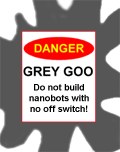
The research of Arpad Putzai about a decade ago in which he fed genetically modified potatoes to rats and purportedly observed deleterious effects, kicked off the whole anti-GM movement in the UK. In a recent Guardian interview with Pusztai, his current position on the subject is probably best summed up by an early quote from the interview:
“We’re eating things that we haven’t eaten before, and I challenge anyone to be able to predict what will be the consequences of this, particularly the consequences for our immune system.”
One might argue that today we are consuming thousands of things that were not available to ancestors from bananas and kiwi fruits to chocolate truffles and skinny café latte mochachino with marshmallows and sprinkles. Excess and overindulgence aside, our bodies seem to cope immunologically with a huge range of foodstuffs that are newly available in terms of the evolution of our enzymes.
Indeed, it was Bruce Ames, of Ames test for cancer causing fame, who pointed out that every day the DNA in every cell of our bodies is exposed to thousands of putatively harmful agents and those or mainly from the natural products of the natural environment. So, why should a few GM potatoes engineered to ward off insect larvae without the use of pesticides be any different?
While we may not be adapted to the specifics of GM crops our bodies do seem able to cope with novel foods. Moreover, we are still evolving (just look at the enzymes we have that cope with cow’s milk and alcoholic drinks that apparently occurred only once we became an agricultural species 10,000 years ago. The same argument might be applied to the advent of nanoscience. However, are the lessons science should have learned from the public relations debacle sparked by Pusztai’s revelations ahead of peer review being ignored again as the nanotechnology age dawns?
Nanoparticles and nanocomposites are essentially any substances that exist as collections of individual entities in the size range of 1 to 100 nanometres in diameter. So at least an order of a magnitude bigger than atoms and molecules. The biggest molecules, proteins, some supramolecular structures and the fullerenes all fall below this range, although they almost overlap with the smallest of genuine nanoparticles. Conversely, nothing bigger than a hundred nanometres, a couple of hundred at a push, can be described as nanoscopic, rather at the micrometre scale you are looking (with a microscope) at microscopic particles. So the fullerenes are not nanoparticles and neither are the kind of microscopic particles of asbestos that are known to cause serious health problems. Nanoparticles are in between these two extremes.
Nanotechnology is, of course, an entirely different simmering pan of aquatic chordates than GMOs. Although saying that we have co-existed with organisms that are genetically modified throughout evolution as well as particles that just happen to be in the size range 1 to 100 nm.
Nevertheless a whole field of nanotoxicology has emerged over the last three or four years and a forthcoming special issue of the International Journal of Nanotechnology (IJNT, 2008, vol 5(1), pp 1-160) will cover many of the issues as well as reporting on various recent studies into the safety or otherwise of nano materials. Among the themes are investigations into the putative effects of nanoparticles on the human lung, blood serum, and epithelial cells, as well as reports covering how to design safety into nanotechnology, and developing a risk management framework. There is certainly a need to monitor the emergence of nano, in terms of occupational, environmental and consumer risks.
Whereas Pusztai’s results published a decade ago triggered a public relations catastrophe from which UK genetic scientists have yet to recover, it doesn’t seem that nanoscience and nanotechnology are going down quite the same road in terms of media scare stories and public anxieties.
As with GM there is huge potential in this burgeoning field of discovery. “Nanomaterials offer tremendous societal benefit,” says cell biologist Thomas Weber of Pacific Northwestern Laboratory, guest Editor of the special issue of IJNT “from improving medicines to everyday items such as automobiles and aircraft or your favourite fishing rod.”
Unfortunately, the tabloids have latched on to the concept of a “grey goo” produced by myriad self-replicating nanobots of which K Eric Drexler warned in his nano-pioneering 1986 book The Engines of Creation, but that is probably an impossibility. Such nanobots are themselves likely to be many decades away and will because of the laws of supply and demand be all-but self limited. It is interesting that the cosmetics industry learned the public relations lesson very quickly, however, quickly discarding the nano label from products that contain liposomes, for instance, before consumers began worrying about their face turning to grey goo.
PNL’s Weber is well aware of the potential for a public relations crisis when it comes to nanoscience. “There are diverse types of nanomaterials being produced with unknown toxic potential,” he says, “This combination requires responsible stewardship by the scientific community over this rapidly developing field to enable maximum benefits while minimizing negative outcomes.”
“Advances are being made on various fundamental scientific aspects of the toxicity of nanomaterials as well as on rapid-screening tools to assess toxicity,” explains SK Sundaram, also at PNL, and a guest Editor on the IJNT special issue, “These advancements will help in enhancing the public awareness and dispelling many myths in this field, we hope.”
Despite the imaginary notion of a ubiquitous grey goo, the relative lack of tabloid media interest may be due in part to the diverse and esoteric nature of nanoscience. Whereas anyone might imagine some kind of monster GM tomato, it is rather difficult to visualise the scale of nanoparticles and of what they are composed, let alone how such particles might behave.